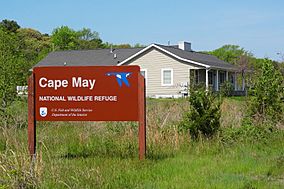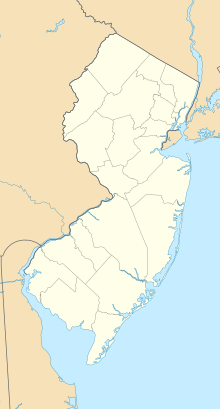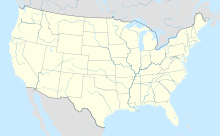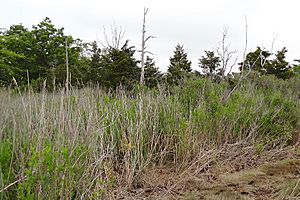Cape May National Wildlife Refuge facts for kids
Quick facts for kids Cape May National Wildlife Refuge |
|
|---|---|
|
IUCN Category IV (Habitat/Species Management Area)
|
|
 |
|
| Location | Cape May County, New Jersey |
| Nearest city | South Dennis, New Jersey |
| Area | 21,200 acres (86 km2) |
| Established | 1989 |
| Governing body | U.S. Fish and Wildlife Service |
| Website | Cape May National Wildlife Refuge |
The Cape May National Wildlife Refuge is a special protected area located on the Cape May Peninsula in Cape May County, New Jersey. It is part of the National Wildlife Refuge System and is managed by the United States Fish and Wildlife Service.
This refuge was started in January 1989 with 90 acres (0.36 km2) of land. It has grown a lot since then, now covering more than 11,000 acres (45 km2). There are plans for it to become even bigger, reaching over 21,200 acres (86 km2). The refuge is made up of three separate parts: the Delaware Bay Division, the Great Cedar Swamp Division, and the Two Mile Beach Unit. This area is very important because it provides a home for many migratory birds.
Contents
What Kinds of Animals Live Here?
The Cape May National Wildlife Refuge is a vital home for many different kinds of animals. It supports 317 types of birds, 42 types of mammals, and 55 types of reptiles and amphibians. You can also find many fish, shellfish, and other small creatures here.
This refuge is becoming more and more important for protecting migratory birds. This is because more and more natural areas along the Jersey Shore are being developed into roads, shopping centers, and homes. The unique shape and location of the Cape May Peninsula help to gather many songbirds, raptors (birds of prey), and woodcocks. They all funnel south towards Cape May Point during their fall migration.
Birds often pause here to rest and eat. They need to build up energy before crossing the 12 miles (19 km) wide Delaware Bay. They will wait for good winds to help them cross the bay or fly north along its eastern shore.
Shorebirds: Stopping for a Snack
The refuge has a five-mile stretch along the Delaware Bay. This area is a major resting and feeding spot for migrating shorebirds and wading birds every spring. The Delaware Bay shoreline is known worldwide as a huge gathering place for shorebirds in North America. It's second only to the Copper River Delta in Alaska!
Every year, hundreds of thousands of shorebirds stop here. About 80 percent of some bird populations rest and feed here during their spring migration. They travel all the way from Central and South America to their breeding grounds in the Arctic. More than twenty shorebird species arrive at Cape May. These include red knots, ruddy turnstones, sanderlings, and semipalmated sandpipers.
Their arrival happens at the same time as the horseshoe crab spawning season, which is in May and early June. The eggs from these crabs are a huge food source for the birds. These long-distance flyers use the eggs to get their energy back before continuing their journey. Because of its importance to migrating shorebirds, this area was named a Wetland of International Importance in 1992. It is part of the Delaware Bay Estuary.
Songbirds: Long Journeys
Neotropical migrants are birds that spend their summers in Canada and the U.S. and their winters in Mexico, Central America, or South America. These birds use the many different habitats of the Cape May Peninsula during their long and difficult migrations.
Sadly, many of these bird species are decreasing in number. This is because they are losing their natural homes across much of their travel routes. Almost 100 species of neotropical songbirds stop here to rest and eat. They often use the forest habitats. Many songbird species also build their nests here, such as ovenbirds, wood thrushes, and yellow-throated warblers.
Raptors: Birds of Prey
Cape May Peninsula is famous for its amazing raptor migrations each fall. During this time, you can see many of 17 different raptor species. These include peregrine falcons, ospreys, northern harriers, American kestrels, and Cooper's and sharp-shinned hawks.
Many raptors prefer not to fly over large bodies of water like the Delaware Bay. So, they use the forest edge along the bay shore as a migration path. All raptor species found in southern New Jersey can be seen at the refuge. Some, like the red-tailed hawk, live here all year.
After their numbers dropped in the 1970s, bald eagles are now nesting on the refuge land again. Owl populations also use Cape May's woodlands a lot in winter. Several owl species, like the barred owl, also nest here.
American Woodcock: Forest Foragers
During their fall migration, these unique upland shorebirds gather in huge numbers in Cape May's moist woodlands and thickets. They use these habitats to find food. They can eat more than their own weight in earthworms every day to build up their fat reserves. On the East Coast of the United States, only Cape Charles, Virginia has similar large groups of woodcock. The refuge offers excellent resting and feeding habitats for this interesting bird.
Endangered and Threatened Species
The threatened piping plover uses the Two Mile Beach Unit for feeding and resting. Many species listed as threatened in New Jersey have been found within the refuge. These include ospreys, short-eared owls, barred owls, red-shouldered hawks, grasshopper sparrows, great and little blue herons, red-headed woodpeckers, sedge wrens, yellow-crowned night-herons, northern harriers, and black rails.
Other rare animals found here are southern gray tree frogs, eastern tiger and mud salamanders, corn snakes, and northern pine snakes.
A unique plant called swamp pink, which is on the Federal List of Endangered and Threatened Plants, also grows in the refuge. There are also 34 other plant species listed as threatened in New Jersey.
Fishery Resources: Food from the Water
The marshes and tidal creeks of the Cape May National Wildlife Refuge are important nursery areas. They provide food and nutrients for many popular types of fish and shellfish. These include summer flounder, weakfish, striped bass, blue crabs, and lady crabs.
These fisheries offer plenty of food for wildlife and for people too. Seventy percent of the species that recreational and commercial fishermen look for depend on shallow water habitats. These habitats, like those found in the refuge, are crucial for at least part of their lives.




